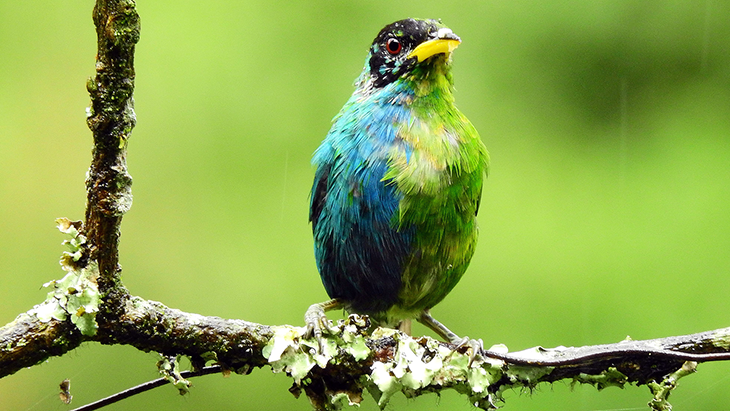
During a visit to Colombia, a Kiwi professor specializing in zoology, Professor Hamish Spencer, experienced an astonishing revelation that left an indelible mark on his life. Despite Colombia boasting the highest diversity of birds, both endemic and overall, the true surprise came when Professor Spencer and his companion encountered a captivating honeycreeper adorned in vibrant blue and green plumage.
Accompanied by amateur ornithologist John Murillo, the two were captivated by the peculiar appearance of the honeycreeper. Professor Spencer, recognizing the rarity of the sighting, believed it to be a once-in-a-lifetime addition to his birdwatching checklist. The situation escalated when Murillo, demonstrating a keen eye and photographic skill, managed to capture striking still images of the green honeycreeper.
What made this avian spectacle even more extraordinary was the revelation that the honeycreeper exhibited a “bilateral gynandromorph” condition. This meant that the bird displayed a distinctive characteristic of having both female and male plumage, with an astonishing division of colors – one half adorned in brilliant blue and the other in vibrant green. The encounter with this bilateral gynandromorph added a unique and unexpected chapter to the professor’s exploration of Colombia’s rich birdlife.
“Many birdwatchers could go their whole lives and not see a bilateral gynandromorph in any species of bird. The phenomenon is extremely rare in birds, I know of no examples from New Zealand ever,” Spencer had said.
Murillo and Spencer recently released a groundbreaking paper detailing their significant discovery, which has been published in the prestigious Journal of Field Ornithology. This noteworthy revelation marks only the second occurrence of a bilateral gynandromorph observed in this particular bird species over the past century.
Professor Spencer emphasizes the importance of gynandromorphs in advancing our comprehension of sex determination and sexual behavior among avian species. These unique individuals, possessing both male and female characteristics, offer invaluable insights into the complexities of avian biology.
The documented instances of gynandromorphism are primarily concentrated in animal species characterized by pronounced sexual dimorphism. This phenomenon is most frequently observed in insects, particularly butterflies, as well as in crustaceans, spiders, and even in more diverse taxa such as lizards and rodents. The prevalence of gynandromorphs across a range of species underscores the significance of exploring their occurrence to unravel the intricate dynamics of sex determination and behavior in the animal kingdom.
“The phenomenon arises from an error during female cell division to produce an egg, followed by double-fertilization by two sperm,” Spencer explained when he spoke about it in his university press.
He anticipates that the newfound discovery will encourage individuals to value “exceptions,” as they consistently unveil something intriguing.
“Be always on the lookout for oddities—who will find the first New Zealand example of a bilateral gynandromorph in a bird?”
What are your thoughts? Please comment below and share this news!
True Activist / Report a typo


